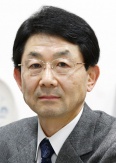Comprehensive List of Researchers "Information Knowledge"
Department of Media Science
- Name
- OHNISHI, Noboru
- Group
- Intelligent Media Engineering Group
- Title
- Professor
- Degree
- Dr. of Engineering
- Research Field
- Human information processing / Robot vision and audition / Rehabilitation engineering

Current Research
Brain Analysis, Realization and Support
OUTLINEThe human brain is an excellent natural machine that performs important information processing such as seeing (vision), listening (audition), understanding languages, and motion controlling.
We focus our interests on the modeling of these information processing (human information processing). From an engineering perspective, we analyze the mechanisms of human information processing and realize them on computer systems such as robot vision, robot audition, and natural language processing. Furthermore, understanding these functions also helps enhance the field of rehabilitation engineering, which aims to realize sensory substitution systems for persons with visual or hearing impairments.
TOPICS
(1) Analysis of Human Information Processing
The analysis and modeling of human information processing is important not only for the pursuit of scientific truth but also for artificial realizations of biological systems. We model and simulate human audio-visual information processing based on physiological and psychological knowledge. So far, we have conducted the researches on analysis of the binocular gazing point, perceptual models of figure and transparency, models of generating subjective contour, and emotion embedded in speech, Now we are studying audio-visual event corresponding, which is the basis of sensor fusion and the acquisition of object knowledge.
(2) Robot Vision and Audition
Humans understand their environment by using their eyes and ears. They can localize a sound source location (source localization) and recognize the sound (source discrimination). Furthermore, they can listen to one sound among other simultaneously existing sounds (source separation). Humans also understand the back-and-forth relation of multiple objects (depth perception), an object's 3D shape (shape recovery), and recognize objects (object discrimination).
So far, we have conducted the following researches : a sound source localization system inspired by mechanisms in living organisms ; basic methods for blind source separation ; extraction of inner contour based on the subject contour generation model ; a method for detecting object overlapping based on the transparency perception model ; 3D shape recovery from shading information ; and the extraction of character strings in a scene image. Currently we are studying source discrimination in indoor/outdoor environments, blind source separation in the real world, the extraction of character information in an outdoor scene image, and the estimation of emotion from both speech and faces.
(3) Rehabilitation Engineering (sensory substitution)
The human's fundamental functions are seeing, listening, speaking, and motion controlling. Using these functions, they communicate with others, systems and environments. Impaired persons, however, have difficulty understanding and communicating with their environment. We have developed a diagram recognition system for blind persons, a system for acquiring spatial awareness, and a system for imparting character information to the blind. Now we are engaged in detecting such emergency sounds as horns.
The researches described above are applicable to audio-visual scene monitoring and the realization of artificial eyes and ears necessary in autonomous robots. Our research principle is to extend human ability and aid human activity.
.jpg)
Figure : Audio-visual scene understanding
Career
- Noboru Ohnishi received an M. Eng. degree in Electrical Engineering and Electronics in 1975 and a Dr. Eng. degree in Information Engineering in 1984 from Nagoya University. He was a researcher of the REC under the Ministry of Labor from 1975 to 1986.
- He joined Nagoya Univ. as an Assistant Professor and became an Assoc. Professor (1989-1994).
- From 1993 to 2001, he concurrently held the head position at the Laboratory for Bio-mimetic Sensory System at the Bio-mimetic Control Research Center of RIKEN.
- Since 1994, he has been a professor at Nagoya University.
Academic Societies
- IEEE
- IEICE
- IPSJ
- IEE
- SICE
- RSJ
- JNNS
- ITE
Publications
- Information Processing in Biological Systems, Shoko-do, 2001.
- A System for Extracting Character Information in the Environment for Visually Impaired People, IEEJ Trans. on Electronics, Information and Systems, Vol. 124-C, No. 6 (2004).
- Blind Signal Separation for convolved Non-Stationary Signals, IEICE Trans. on Fundamentals, Vol. J82-A, No. 8 (1999).








